Silent Era Home Page > Home Video > The Cabinet of Dr. Caligari

Reviews of silent film releases on home video.
Copyright © 1999-2025 by Carl Bennett
and the Silent Era Company.
All Rights Reserved. |
|
The Cabinet of
Dr. Caligari
(1920)
|
The Cabinet of Dr. Caligari (1920) is a tale of a mysterious showman who arrives in a small European town at the time of their annual fair. He intends to amaze the crowds with a genuine somnambulist who knows the past and sees the future. Outside of the sideshow, however, Caligari the showman has sinister plans.
Immediately a series of murders are committed in the town. Suspicion quickly falls on Caligari and his sleepwalker Cesare (Conrad Veidt). But a thief also becomes a suspect.
When Cesare cannot bring himself to murder the beautiful Jane, he kidnaps her, and is hunted by the angry people of the village. Caligari eventually flees the wrath of the mob, and is traced back to an insane asylum.
Werner Krauss’ Dr. Caligari is wonderfully played to archtypical levels, and Veidt delivers a stand-out performance as the somnambulist. Lil Dagover is gorgeous as Jane, and Friedrich Fehér as Franzis is at times animatedly maniacal.
The film may have introduced what we today refer to as the unreliable film narrator. Upon multiple viewings, we see that our observation of the film’s events is skewed and thus our perceptions are quite questionable upon reflection. The simple but compelling story is augmented by the much-acclaimed expressionist set design that is full of angles and painted shafts of light and shadow. The angular settings and exaggerated makeup emphasize the bizarre world occupied by the mad Caligari. The film’s cramped, off-center and uneasy world is perfectly communicated to the viewer, and there can be no mistaking it: it is a mad world, but its denizens are not aware of it. Caligari remains a deliciously intriguing film, and one of world cinema’s required viewings.
— Carl Bennett
|
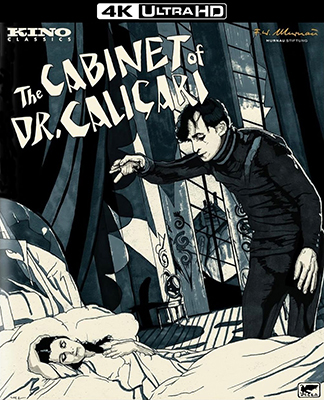 Kino Classics Kino Classics
2024 UltraHD / Blu-ray Disc edition
The Cabinet of Dr. Caligari (1920), color-tinted black & white, and color-tinted and color-toned black & white, 77 minutes, not rated.
Kino Lorber, K26771, UPC 7-38329-26771-1.
One single-sided, dual-layered, Region A UltraHD Blu-ray Disc; 1.33:1 aspect ratio picture in pillarboxed 16:9 (3840 x 2160 pixels) 24 fps progressive scan image encoded in HDR HEVC format at 89.6 Mbps average video bit rate; DTS-HD Master Audio 5.1 surround sound encoded at 2.4 Mbps average audio bit rate (Beal score), DTS-HD Master Audio 2.0 stereo sound encoded at 1.6 Mbps audio bit rate (Beal and Freiburg scores), DTS-HD Master Audio 2.0 stereo sound encoded at 1.6 Kbps audio bit rate (commentary and featurettes), and DTS-HD Master Audio 2.0 stereo sound encoded at 1.6 Kbps audio bit rate (SDH commentary); German language intertitles, optional English language subtitles; 10 chapter stops; closed captions; and one single-sided, dual-layered, Region A Blu-ray Disc; 1.33:1 aspect ratio picture in pillarboxed 16:9 (1920 x 1080 pixels) 24 fps progressive scan image encoded in SDR AVC format at 39.2 Mbps average video bit rate; DTS-HD Master Audio 5.1 surround sound encoded at 2.3 Mbps average audio bit rate (Beal score), DTS-HD Master Audio 2.0 stereo sound encoded at 1.6 Mbps audio bit rate (Beal and Freiburg scores), and Dolby Digital (AC3) 2.0 stereo sound encoded at 192 Kbps audio bit rate (Miller score, commentary, SDH commentary and featurettes); German language intertitles, optional English language subtitles; 10 chapter stops; closed captions; standard two-disc UHD keepcase; $39.95.
Release date: 22 October 2024.
Country of origin: USA
Ratings (1-10): video: 9 / audio: 8 / additional content: 8 / overall: 8.
|
|
This UltraHD edition has been mastered at 4K high-resolution from the 2014 restoration of the film conducted by the Friedrich-Wilhelm-Murnau-Stiftung, which compiled the best images from 35mm and 16mm reduction print elements. Missing film footage in the main source material has been inserted from other 35mm and 16mm elements. Owners of the 2014 Kino Blu-ray Disc will ask themselves if it is worth upgrading to this UHD/BD edition. It is our opinion that the 2014 edition was so good that some viewers may not be able to perceive an improvement in visual quality. Sharp-eyed UHD hounds, however, will love the additional image detail in the 35mm camera negative footage (the sequence of Cesare first opening his eyes is an OMG Wow!). There may be an 8K HD edition released sometime in the future but it is hard to believe that it will be much of an improvement over this UHD edition.
The remastered Blu-ray Disc fares nearly as well as the UHD disc but is no perceptible visual improvement over the 2014 Kino BD edition noted below. Everything said about the previous edition applies to this remastered disc as well. If you don’t have a UHD player and a 4K monitor but plan to get them in the near future, you can acquire this dual-disc edition in anticipation of that day but enjoy the BD until then.
The film is accompanied by three optional music scores: a jazzy orchestral and choral score by Jeff Beal performed by The Silver Nitrate Big Band and Fourth Wall Ensemble (presented in 5.1 surround and 2.0 stereo) that feels too much like a 1960s Hollywood studio score to serve the film well; a 2014 small ensemble music score performed by the Studio For Film Music at the University of Music, Freiburg (presented in 2.0 stereo), which remains our preferred music score; and a score by Paul D. Miller (D.J. Spooky), which does serve the film well and makes for good standalone listening (BD only, presented in 2.0 stereo); also included is a descriptive audio track for the visually impaired.
Supplemental material includes audio commentary by composer Jeff Beal on his composition; the documentary “Caligari: How Horror Came to the Cinema,” directed by Rüdiger Suchsland and narrated in German with permanent English language subtitles (52 minutes, BD only); and two brief restoration demonstrations, which includes a side-by-side comparison of the 1984 photochemical restoration and the 2014 digital restoration (4 minutes total, BD only), which also incidentally shows that approximately five-percent more of the bottom of the picture is captured in the 2014 restoration.
As would be expected, this UltraHD / Blu-ray Disc set is our highly recommended North American home video edition of the film. So, sleepwalk to your collection, pull your old home video editions of Caligari off the shelf and throw them away. This is the disc you want . . . This is the disc you want . . . Collectors will need an UltraHD Blu-ray Disc player and an UltraHD capable 4K monitor to view this UHD edition.
|
|
This
Region A UltraHD Blu-ray Disc / Region A Blu-ray Disc edition is available directly from . . .
|

|
|
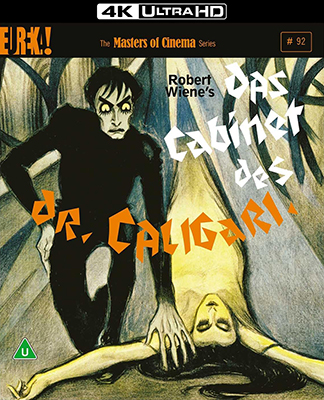 Masters of Cinema Masters of Cinema
2022 UltraHD edition
The Cabinet of Dr. Caligari (1920), color-tinted black & white, and color-tinted and color-toned black & white, 77 minutes, BBFC Classification U.
Eureka Entertainment,
EKA70480 (MoC 92), UPC 5-06000-704808.
One single-sided, dual-layered, Region 0 UltraHD Blu-ray Disc; 1.33:1 aspect ratio picture in pillarboxed 16:9 (3840 x 2160 pixels) 24 fps progressive scan image encoded in HDR HEVC format at 90.8 Mbps average video bit rate; DTS-HD Master Audio 5.1 surround sound encoded at 3.8 Mbps average audio bit rate (Schwer score), LPCM 2.0 stereo sound encoded at 2.3 Mbps audio bit rate (Schwer and Dierksen-Kretzschmar scores), and Dolby Digital (AC3) 2.0 stereo sound encoded at 192 Kbps audio bit rate (commentary and featurettes); German language intertitles, optional English language subtitles; 6 chapter stops; 100-page insert book; standard UHD keepcase in cardboard slipcase; £29.99 (reduced to £19.99).
Release date: 6 December 2022.
Country of origin: England
Ratings (1-10): video: 9 / audio: 8 / additional content: 8 / overall: 8.
|
|
This 4K UltraHD Limited Edition release has been mastered from the 2014 restoration of the film conducted by the Friedrich-Wilhelm-Murnau-Stiftung, which compiled the best images from 35mm and 16mm reduction print elements. Missing film footage in the main source material has been inserted from other 35mm and 16mm elements; the geometry of the image alignment from print to print is flawless with only the change in image quality to signal the difference. Scanned at 4K high-definition, the image has for the most part been stabilized and cleaned with some corrected exposure fluctuations. The resulting picture is stunning. Allowed to remain are some historic film flaws such as film processing artifacts, splice artifacts, a minute amount of dust, and print warps. We feel that many of these remaining flaws could have been digitally removed to further improve the viewing experience.
We feel it must be said that we initially opposed silent film releases on Blu-ray Disc primarily because early BDs overemphasized film grain in a digital scan for the sake of a perceived sharpness of the image. We feel that a high-definition picture should emulate, as close as possible, the most filmlike image obtainable — sacrificing the illusion of sharpness in favor of the smooth continuous tones of film. Over the past 20 years, digital scannning technology has improved to the point that most present-day Blu-ray Disc presentations are superior at delivering a highly filmlike picture without oversharpening film grain. Any similar concerns we may have had regarding 4K home video presentations of silent films have been dismissed by this UltraHD edition.
The film is accompanied by two optional music scores: a score by Cornelius Schwer (presented in 5.1 surround and 2.0 stereo), and a score by Uwe Dierksen and Hermann Kretzschmar (2.0 stereo).
Supplementary material includes audio commentary by historians Kevin Lyons and Jonathan Rigby; audio commentary by historian David Kalat; featurette interview “The Asylum in Film” by horror historian Kim Newman (14 minutes); video essay “You Must Become Caligari” by historian David Cairns (16 minutes); featurette “Caligari: The Birth of Horror in the First World War” with German narration and English subtitles (53 minutes); three brief featurettes on the film’s restoration with German narration and English subtitles (9 minutes); and a 100-page book including vintage writing on the film by Lotte H. Eisner, an original Variety review of the film, rare images, and more. The Lyons-Rigby commentary is chattier in presentation and the Kalat commentary imparts far more historic information; our listening preference will depend on our current mood.
This second UltraHD edition of a silent era film is highly recommended as the best available European home video edition of the film. Collectors will need an UltraHD Blu-ray Disc player and an UltraHD capable 4K monitor to view this UHD edition that is limited to 3000 sets total.
|
|
This Region 0 UltraHD Blu-ray Disc edition is available directly from . . .
|

|
|
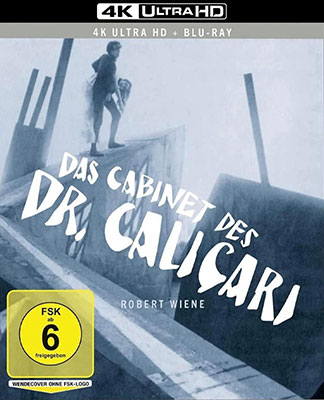 OneGate Media OneGate Media
2022 UltraHD / Blu-ray Disc edition
The Cabinet of Dr. Caligari (1920), color-tinted black & white, and color-tinted and color-toned black & white, 77 minutes, FSK Rated 6.
OneGate Media,
unknown catalog number, unknown UPC number.
One single-sided, dual-layered, Region B UltraHD Blu-ray Disc; 1.33:1 aspect ratio picture in pillarboxed 16:9 (3840 x 2160 pixels) 24 fps progressive scan image encoded in HDR HEVC format at ? Mbps average video bit rate; Dolby Digital (AC3) 2.0 stereo sound encoded at ? Kbps audio bit rate; German language intertitles, optional English language subtitles; chapter stops; and one single-sided, dual-layered, Region B Blu-ray Disc; 1.33:1 aspect ratio picture in pillarboxed 16:9 (1920 x 1080 pixels) 24 fps progressive scan image encoded in SDR AVC format at ? Mbps average video bit rate; LPCM 2.0 stereo sound encoded at ? Mbps audio bit rate; German language intertitles, optional English language subtitles; chapter stops; 20-page insert booklet; standard two-disc UHD keepcase; €19.99.
Release date: 13 May 2022.
Country of origin: Germany
|
|
This 4K UltraHD edition has been mastered from the 2014 restoration of the film conducted by the Friedrich-Wilhelm-Murnau-Stiftung.
The film is accompanied by a music score composed by Uwe Dierksen and Hermann Kretzschmar.
Supplementary material includes the featurette “Caligari: The Birth of Horror in the First World War” (53 minutes); three brief featurettes on the film’s restoration (9 minutes); and a 20-page insert booklet.
This first-ever UltraHD edition of a silent era film will require an UltraHD Blu-ray Disc player and an UltraHD capable 4K monitor to view this UHD edition.
|
|
This Region B UltraHD Blu-ray Disc edition is available through . . .
|

|
|
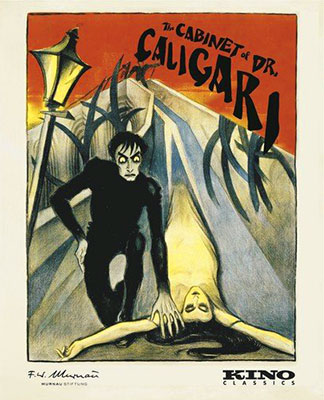 Kino Classics Kino Classics
2014 Blu-ray Disc edition
The Cabinet of Dr. Caligari (1920), color-tinted black & white, and color-tinted and color-toned black & white, 77 minutes, not rated.
Kino Lorber, K1515, UPC 7-38329-15152-2.
One single-sided, dual-layered, Region A Blu-ray Disc; 1.33:1 aspect ratio picture in pillarboxed 16:9 (1920 x 1080 pixels) 24 fps progressive scan image encoded in SDR AVC format at 35.0 Mbps average video bit rate; DTS-HD Master Audio 2.0 stereo sound encoded at 1.6 Mbps audio bit rate; German language intertitles, optional English language subtitles; chapter stops; 4-page insert booklet; standard BD keepcase in cardboard slipcase; $29.95.
Release date: 18 November 2014.
Country of origin: USA
Ratings (1-10): video: 9 / audio: 8 / additional content: 8 / overall: 8.
|
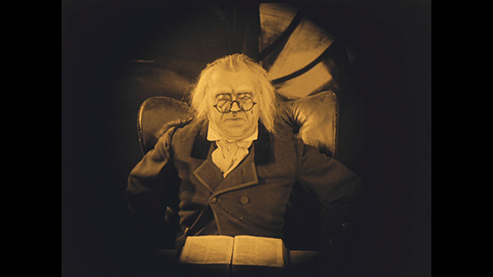
This Blu-ray Disc edition, administered by the Friedrich-Wilhelm-Murnau-Stiftung, has mastered from a high-resolution 4K scan largely from the original 35mm camera negative. Some footage missing from the camera negative has been filled with footage from other prints. According to the prefilm introduction, the entire first reel is missing from the negative. However, the conflated footage is from an excellent 35mm print, which is of such high-quality that it wows the viewer with its clarity. Then Act 2 begins with the camera negative footage and wow again!
With the extra image resolution comes one trade-off: After years of viewing blurry 16mm reduction prints and recent years of better DVD images, the Blu-ray Disc edition gives the viewer an very sharp view of the Expressionistic sets that now seem less a nightmarish dream and more the spare, cheaply painted flats of an early 20th century stage production.
Presented with the original German language art intertitles that were preserved as flash titles in the source material, English language subtitles are available as a viewing option.
This presentation features a music score performed by the Studio For Film Music at the University of Music, Freiburg, with an optional alternate music score by Paul D. Miller (DJ Spooky).
Supplemental materials include: the documentary Caligari: How Horror Came to the Cinema (52 minutes); a insert booklet essay by Kristin Thompson; an image gallery; and a restoration demonstration.
As would be expected, this Blu-ray Disc edition is highly recommended. So, sleepwalk to your film collection. Pull your home video editions of Caligari off the shelf and throw them away. This is the disc you want . . . This is the disc you want . . .
|
|
This Region A Blu-ray Disc edition is available directly from . . .
|

|
|
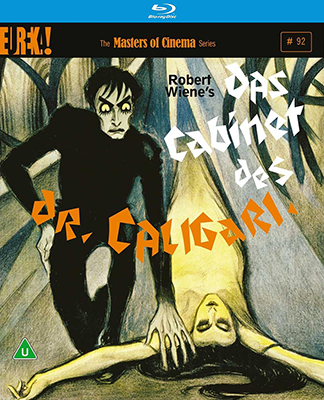 Masters of Cinema Masters of Cinema
2014 Blu-ray Disc edition
The Cabinet of Dr. Caligari (1920), color-tinted black & white, and color-tinted and color-toned black & white, 77 minutes, BBFC Certification PG.
Eureka Entertainment,
EKA70144 (MoC 92), unknown UPC number.
One single-sided, single-layered, Region B Blu-ray Disc; 1.33:1 aspect ratio picture in pillarboxed 16:9 (1920 x 1080 pixels) 24 fps progressive scan image encoded in SDR AVC format at ? Mbps average video bit rate; DTS-HD Master Audio 5.1 surround sound encoded at ? Mbps audio bit rate, and DTS-HD Master Audio 2.0 stereo sound encoded at ? Mbps audio bit rate; German language intertitles, optional English language subtitles; chapter stops; 44-page insert booklet; standard BD keepcase; £14.99.
Release date: 29 September 2014.
Country of origin: England
|
|
This Region B Blu-ray Disc edition administered by the Friedrich-Wilhelm-Murnau-Stiftung, has mastered from a high-resolution 4K scan largely from the original 35mm camera negative. Presented with the original German language art intertitles, English language subtitles are available as a viewing option.
The film is accompanied by two optional music scores: a score by Cornelius Schwer (presented in 5.1 surround and 2.0 stereo), and a score by Uwe Dierksen and Hermann Kretzschmar (2.0 stereo).
Supplementary material includes audio commentary by historian David Kalat; video essay “You Must Become Caligari” by historian David Cairns (16 minutes); featurette “Caligari: The Birth of Horror in the First World War” with German narration and English subtitles (53 minutes); three brief featurettes on the film’s restoration with German narration and English subtitles (9 minutes); and a 44-page booket including vintage writing on the film by Lotte H. Eisner, an original Variety review of the film, rare images, and more.
North American collectors will need a region-free Blu-ray Disc player to view this edition.
|
|
This Region B Blu-ray Disc edition is available directly from . . .
|

|
|
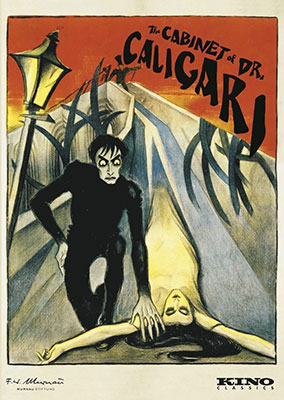 Kino Classics Kino Classics
2014 DVD edition
The Cabinet of Dr. Caligari (1920), color-tinted black & white, and color-tinted and color-toned black & white, 77 minutes, not rated.
Kino Lorber, K1514, UPC 7-38329-15142-3.
One single-sided, single-layered, Region 1 NTSC DVD disc; 1.33:1 aspect ratio picture in pillarboxed 16:9 (720 x 480 pixels) anamorphic interlaced scan image encoded in SDR MPEG-2 format at ? Mbps average video bit rate (capable of progressive scan upscaling to ? fps); Dolby Digital (AC3) 2.0 stereo sound encoded at ? Kbps audio bit rate; German language intertitles, optional English language subtitles; chapter stops; 4-page insert booklet; standard DVD keepcase in cardboard slipcase; $29.95.
Release date: 18 November 2014.
Country of origin: USA
Ratings (1-10): video: 8 / audio: 8 / additional content: 8 / overall: 8.
|
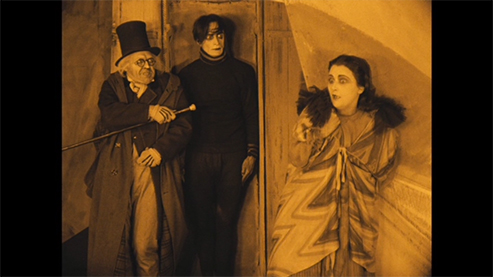
This remastered DVD edition, administered by the Friedrich-Wilhelm-Murnau-Stiftung, has mastered from a high-resolution 4K scan largely from the original 35mm camera negative. Presented with the original German language art intertitles, English language subtitles are available as a viewing option.
Unlike older Caligari DVDs, this remastered Kino edition is presented as a pillarboxed standard picture within a 16:9 widescreen screen ratio for today’s HD monitors.
This presentation features a music score performed by the Studio For Film Music at the University of Music, Freiburg, with an optional alternate music score by Paul D. Miller (DJ Spooky).
Supplemental materials include: the documentary Caligari: How Horror Came to the Cinema (52 minutes); a insert booklet essay by Kristin Thompson; an image gallery; and a restoration demonstration.
For those collectors who have not jumped to Blu-ray Disc, this is the recommended DVD edition of the film.
|
|
This Region 0 NTSC DVD edition is available directly from . . .
|

|
|
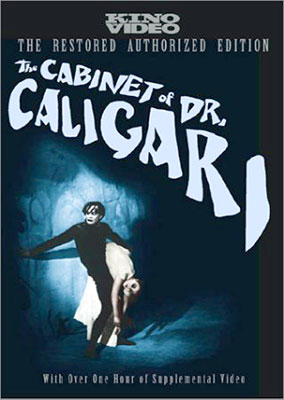 Kino on Video Kino on Video
2002 DVD edition
The Cabinet of Dr. Caligari (1920), color-tinted and color-toned black & white, 75 minutes, not rated, with Genuine (1920) [excerpts], color-tinted and color-toned black & white, 44 minutes, not rated.
Kino International, K254, UPC 7-38329-02542-7.
One single-sided, single-layered, Region 0 NTSC DVD disc; 1.33:1 aspect ratio picture in full-frame 4:3 (720 x 480 pixels) interlaced scan image encoded in SDR MPEG-2 format at 7.0 Mbps average video bit rate (capable of progressive scan upscaling to 60 fps); Dolby Digital (AC3) 2.0 stereo sound encoded at 192 Kbps audio bit rate; English language intertitles, no subtitles; 12 chapter stops; two-page insert sheet; standard DVD keepcase; $24.95.
Release date: 24 September 2002.
Country of origin: USA
Ratings (1-10): video: 7 / audio: 8 / additional content: 7 / overall: 7.
|
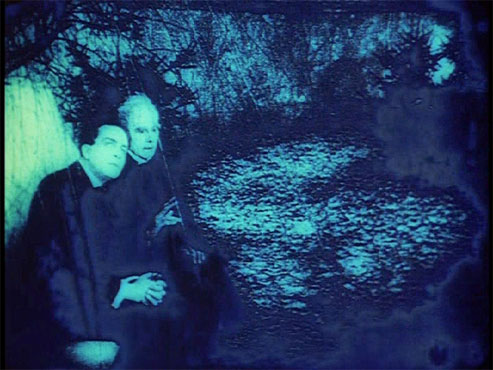
This DVD edition from Kino International has been prepared from a 35mm print restored by the Bundesarchiv-Filmarchiv, and is administered by Transit Film of Germany for the Friedrich-Wilhelm-Murnau-Stiftung.
The restoration print is an uneven compilation of footage, apparently from a couple of sources. Early in the film the emulsion of the source print was beginning to decompose creating a halo effect that produces lighter areas in the darkest portions of the picture (see right). While it is quite distracting, the effect is only apparent in the source print’s blue-tinted shots. Some of the early shots of Franzis talking to an older man appear to have been copied from a mediocre 16mm reduction print. However, the majority of the restoration print appears to have been duplicated from very-good to excellent 35mm materials. The print has a moderate amount of speckling, emulsion scuffing, frame jitters and dust. The Transit Film print is not compromised by the frame misalignment of the Russian print that the 1997 Image Entertainment edition was prepared from (see review below).
Kino International has done a good job of emulating the original German intertitles, with their slowly panning down long hand-painted cards, in this English language edition translated by Kinograph Montreal. The English-speaking viewer is afforded a sense of the style of the German original while enjoying the film in a language they will understand. Of note is the retention of act division intertitles, which are excised from some editions of the film.
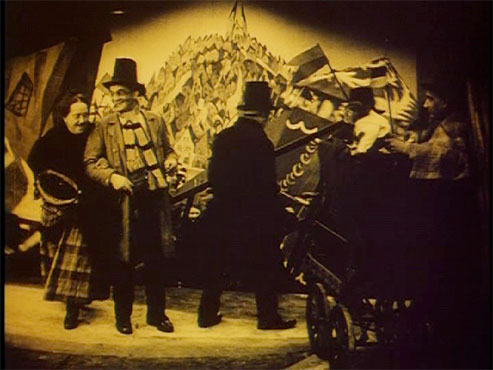
The video transfer is excellent with its sharper image details and lack of visible sharpening artifacts (as compared to the Image edition). There is a normal amount of speckling, frame jitters, moderate dust and other minor flaws in the print, but this presentation fares far better than other home video editions of the film. Our reevaluation of the DVD on high-definition equipment, with an upscaled signal to full 1080p HD, forces us to be realistic about our original grading of the disc, with the surviving footage being of lesser quality than our quality-starved eyes originally saw in this disc. The transfer itself does well in HD, but the surviving material doesn’t.
The film is accompanied by two stereo music scores: the Audio 1 track features an synthesizer, guitar, piano, saxophone, bass and percussion music score composed by Rainer Viertblöck; the Audio 2 track features a score composed and performed on synthesizers by Donald Sosin. Since there is no getting away from synthesizers in this edition, a viewer’s selection of which track to listen to will be based on mood preference. The Viertblöck score is eerily atmospheric and conveys the film’s unsettling premise but will annoy some listeners with its atonality. The Sosin score takes a lively but traditional orchestral approach to its accompaniment of the film, but it is ultimately a synthesizer score — that is, the score is satisfyingly composed but is sold short by its synthesizer arrangement.
The supplementary section includes a 44-minute condensation of Caligari director Robert Wiene’s Genuine (1920) which represents nearly all of the surviving footage, a sketch, photo and posters gallery (40 images, not counting detail closeups), 35mm clips of Wiene on the set of I.N.R.I. (1923) (3 minutes), and exerpts from a German language print showing the calligraphic artwork of a few of the original intertitles (7 minutes).
While it is not perfect, we enjoy watching this edition because of the sharp picture details, the lack of a misframing line, and its faithful emulation of the original German intertitles. We highly recommend this edition of the film.
|
This Region 0 NTSC DVD edition has been discontinued
and is . . .
|

|
|
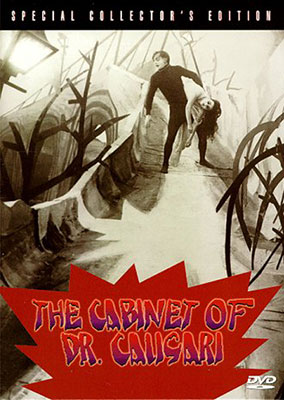 Film Preservation Associates Film Preservation Associates
1997 DVD edition
The Cabinet of Dr. Caligari (1920), color-tinted and color-toned black & white, 72 minutes, not rated, with Genuine (1920) [excerpts], black & white, 3 minutes, not rated.
Film Preservation Associates, distributed by Image Entertainment, ID4099DSDVD, UPC 0-14381-40992-5.
One single-sided, single-layered, Region 0 NTSC DVD disc; 1.33:1 aspect ratio picture in windowboxed 4:3 (720 x 480 pixels) interlaced scan image encoded in SDR MPEG-2 format at 6.2 Mbps average video bit rate (capable of progressive scan upscaling to 60 fps); Dolby Digital (AC3) 2.0 stereo sound encoded at 192 Kbps audio bit rate; English language intertitles, no subtitles; closed captions; 18 chapter stops; snapper DVD case (reissued in standard DVD keepcase); $29.99.
Release date: 15 October 1997.
Country of origin: USA
Ratings (1-10): video: 6 / audio: 8 / additional content: 4 / overall: 6.
|
|
This film is among our favorites, but over the years we have had to endure watching substandard home video versions of the film. Videotape versions from budget-line and public-domain distributors were a horrid viewing experience. The laserdisc version from Republic Pictures Home Video was OK. But when this edition produced by David Shepard was released, a massive hooray was heard. The source material is still not perfect, but it is a vast improvement over the older videotape editions and is one of the best editions of this film available on home video.
This early DVD edition of Caligari, which first appeared on laserdisc and videotape in the mid-1990s, features new intertitles designed and typeset to emulate the original expressionistic German intertitles. Unlike the original intertitles in German which slowly panned down to reveal longer sentences, this edition uses static intertitles with sentences broken up between multiple title cards. This edition also does not include the divisions of acts that were used in the German original. The transfer has been color-tinted and color-toned and the picture image is quite clear when compared to other home video editions of Caligari.
The DVD is augmented by a chamber orchestra music score composed and conducted by Timothy Brock. Compared to the music tracks of the Kino edition, we slightly favor this Brock score for its traditional instrumentation and eerie quirkiness.
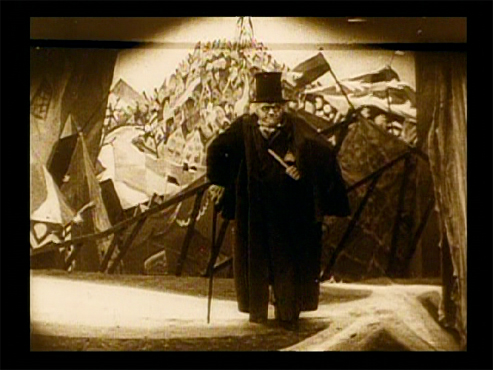
This edition’s video transfer utilized a 35mm print struck in Russia, probably from an early generation nitrate duplicate negative. However, in the silent era and from country to country, there was no worldwide standard for the position of the image’s frame in relation to the film’s perforated sprocket holes. The standard later established and still in effect today has the image area lined on both sides by eight sprocket holes (four on each side of the image) and puts the horizontal frame line in between two perforations. Caligari was apparently shot with a camera that placed the horizontal frame line centered on two of the perforations. When the Russian print was struck, some anonymous Russian film lab technician failed to adjust the film printer to allow for the difference in frame lines. The result was a print with a visible frame line running through the image; most of the bottom part of the picture was at the top and a sliver of the top of the picture was at the bottom. Preservation prints taken from this Russian print have adjusted for the original frame line of the German camera, but now a visible frame line appears at the top of the picture (see above). A sliver of image at the top and the bulk of the image at the bottom now overlap slightly within the visible dark horizontal frame line.
Previous video transfers of this source material (we wonder, are there any?) would have dodged the problem by cropping the picture area tight enough to avoid the frame line, but the surrounding image area would disappear on all sides of the new framing and heads would be cut off. Shepard decided to approach the video transfer of the print on a shot-by-shot basis. Where it was deemed necessary to see all of the original image, the frame line was allowed to be seen in the transfer. Where it was felt that a shot could be shown without losing any essential action or important background visual information, the image was cropped tight enough to remove the frame line. The result is a largely more-open framing of the film. In shots of the busy Holstenwall fair, a merry-go-round is now seen at the left of the picture that was nonexistent in other editions of the film. More so than before, we can see the top of heads.
Our reevaluation of the original pressing of this disc, on high-definition equipment with an upscaled signal to full 1080p HD, reinforces our original grading of the DVD’s video quality (the noted frame line not withstanding). The video transfer, with its color-toning predominantly in sepia, holds a bit more of the highlight details that become washed-out in the strong color-tinting of the Kino edition noted above. The video details are themselves a bit soft, partially the source print and partially the standard resolution video transfer, but not to the point of downgrading the score of the disc.
We suggest for consideration that a film preservation team could take a high-definition transfer of the original Russian print and digitally repair the frame line discrepancy for good. The repaired film could then be imaged to a preservation 35mm safety film negative. The digital work would be expensive, but wouldn’t it be worth the money to restore a film that is certainly one of the ten greatest films of the silent era?
All surviving footage has been included in this edition. The disc includes some uncut shots that were previously shortened in English language editions: for example, where Alan reads the murder announcement on the wall, where Francis reads the placard on the wall of the insane asylum, and where Caligari sees the words “Du musst Caligari werden” all around him.
The disc is supplemented by 3 minutes of exerpts — two scenes — from director Robert Wiene’s film, Genuine (1920), accompanied by a piano score by Robert Israel. Also included is an audio commentary track by Mike Budd. Informative, we suppose, but dull.
|
This Region 0 NTSC DVD edition has been discontinued
and is . . .
|

|
|
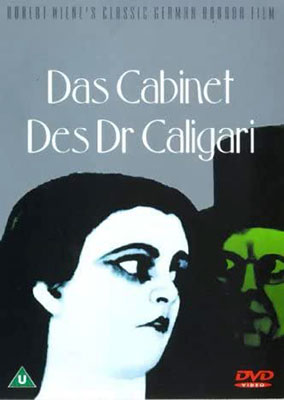 Eureka Entertainment Eureka Entertainment
2000 DVD edition
The Cabinet of Dr. Caligari (1920), black & white, 72 minutes, BBFC Classification U, with Genuine (1920) [excerpts], black & white, 3 minutes, BBFC Classification U.
Eureka Entertainment,
unknown catalog number, unknown UPC number.
One single-sided, single-layered, Region 2 PAL DVD disc; 1.33:1 aspect ratio picture in full-frame 4:3 (720 x 576 pixels) interlaced scan image encoded in SDR MPEG-2 format at ? Mbps average video bit rate (capable of progressive scan upscaling to ? fps); Dolby Digital (AC3) 2.0 stereo sound encoded at ? Kbps audio bit rate; English language intertitles, no subtitles; chapter stops; standard DVD keepcase; £19.99.
Release date: 18 September 2000.
Country of origin: England
|
|
This PAL DVD edition has likely been mastered from the best available 35mm film elements. The content may be identical to the Image edition noted above.
North American collectors will need a region-free PAL DVD player capable of outputting an NTSC-compatible signal to view this edition.
|
This Region 2 PAL DVD edition has been discontinued
and is . . .
|

|
|
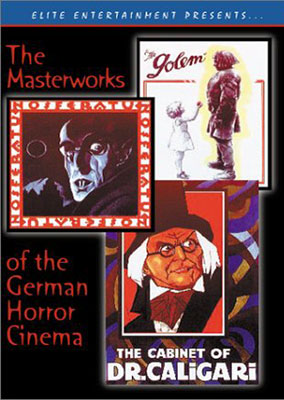 Elite Entertainment Elite Entertainment
2000 DVD edition
The Masterworks of the German Horror Cinema (1920-1922), black & white, 175 minutes total. not rated, including The Cabinet of Dr. Caligari (1920), black & white, 51 minutes, not rated.
Elite Entertainment, EE 4376, UPC 7-90594-43762-6.
One double-sided, single-layered, Region 0 NTSC DVD disc (two DVDs in the set); 1.33:1 aspect ratio picture in full-frame 4:3 (720 x 480 pixels) interlaced scan image encoded in SDR MPEG-2 format at 7.0 Mbps average video bit rate (capable of progressive scan upscaling to 60 fps); Dolby Digital (AC3) 2.0 mono sound encoded at 192 Kbps audio bit rate; English language intertitles, no subtitles; 8 chapter stops; double-wide two-disc DVD keepcase; $54.95 (reduced to $49.95).
Release date: 22 February 2000.
Country of origin: USA
Ratings (1-10): video: 3 / audio: 3 / additional content: 7 / overall: 3.
|
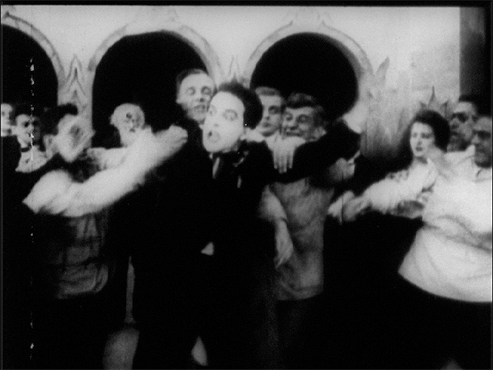
The Cabinet of Dr. Caligari remains one of the most-discussed silent era films. Its imagery is among the silent era’s most influential. So, why hasn’t providence saved this important film in better form? True, the David Shepard/Image edition available on DVD and VHS videotape that was transferred from a very good quality Russian print represented a tremendous leap forward in visual quality. But, why aren’t there a flood of good quality editions of this film? The Elite edition of The Cabinet of Dr. Caligari feels like a step backward. The film has been well-transferred (at sound film speed) from a substandard 16mm reduction print originating from Film Renters Inc.
Toss away your budget-line VHS videotape versions of Caligari. At least Elite has produced a definitive transfer of the 16mm prints commonly utilized for those editions. But is that really saying much? While the transfer framing is impeccable, the framing of the 16mm source material removes picture information from all sides, but especially from the top and left sides of the picture. In the shots of the Holstenwall fair, the merry-go-round clearly seen at the left of the picture in the Image edition is nonexistent in the Elite edition.
The downside of the disc includes audio crackling, and the fact that some shots have been shortened: for example, where Alan reads the murder announcement on the wall or where Francis reads the placard to the insane asylum, both seen in the Image edition. But, everything that is wrong with the Elite edition of Caligari ultimately stems from what is wrong with the source materials. (Except, a few master tape glitches appear in the picture at 6:52 into the disc.) It is a disappointment that better materials were not available to the Elite production team.
The Caligari disc (in this two-disc set) is supplemented by the same 3 minute exerpts from director Robert Wiene’s 1920 film, Genuine, that is available in the Image edition of Caligari.
We do not recommend this edition of The Cabinet of Dr. Caligari.
|
This Region 0 NTSC DVD edition has been discontinued
and is . . .
|

|
|
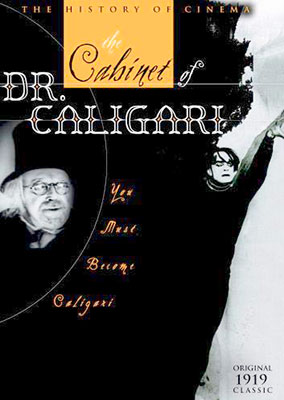 Delta Entertainment Delta Entertainment
2004 DVD edition
The Cabinet of Dr. Caligari (1920), black & white, 70 minutes, not rated.
Delta Entertainment, 82 340, UPC 0-18111-23409-2.
One single-sided, single-layered, Region 0 NTSC DVD-R disc; 1.33:1 aspect ratio picture in full-frame 4:3 (720 x 480 pixels) interlaced scan image encoded in SDR MPEG-2 format at 5.5 Mbps average video bit rate (capable of progressive scan upscaling to 60 fps); Dolby Digital (AC3) 2.0 mono sound encoded at 1.5 Mbps audio bit rate; English language intertitles, no subtitles; 10 chapter stops; standard DVD keepcase; $6.99.
Release date: 24 February 2004.
Country of origin: USA
Ratings (1-10): video: 3 / audio: 3 / additional content: 0 / overall: 3.
|
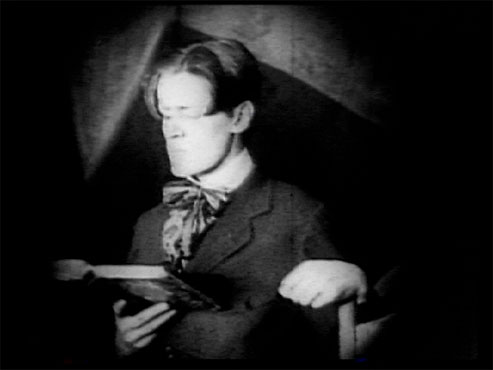
Well, we shouldn’t be surprised. Budget home video distributor Delta Entertainment has released yet another silent film edition that has been prepared from a 16mm reduction print (the substandard 1937 16mm print from Film Renters Inc. as the Elite edition above, to be specific), the same source as a handful of other budget DVDs of The Cabinet of Dr. Caligari.
Much of what is wrong with this edition is the same as what is wrong with others mastered from this material. The print is contrasty (facial details are often blasted out), but manages to hold middle greytones well enough. The print is also moderately sprinkled with dust, and is soft of image details. The video transfer at least
The film is accompanied by a low-fi compiled orchestral soundtrack of preexisting recordings that appears to originate from the Film Renters print.
Because the disc is ultimately nearly identical to other budget DVD editions of this film taken from the same source material, we do not recommend this Delta disc to anyone but the cheap collector.
|
|
DELTA ENTERTAINMENT has discontinued business and this Region 0 NTSC DVD edition is . . .
|

|
|
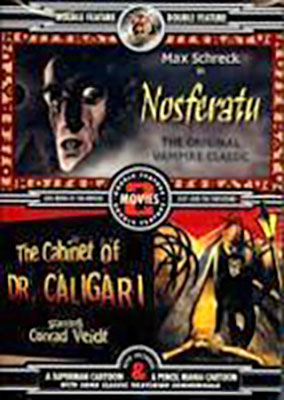 Catcom Home Video Catcom Home Video
2002 DVD edition
Nosferatu (1922), black & white, 80 minutes, not rated, with The Cabinet of Dr. Caligari (1920), black & white, 51 minutes, not rated.
Catcom Home Video, CAT0213-6, UPC 7-41914-02136-0.
One single-sided, dual-layered, Region 0 NTSC DVD disc; 1.33:1 aspect ratio picture in full-frame 4:3 (720 x 480 pixels) interlaced scan image encoded in SDR MPEG-2 format at 5.0 Mbps average video bit rate (capable of progressive scan upscaling to 60 fps); Dolby Digital (AC3) 2.0 mono sound encoded at 192 Kbps audio bit rate; English language intertitles, no subtitles; 3 chapter stops; standard DVD keepcase; unknown suggested retail price.
Release date: 2002.
Country of origin: USA
Ratings (1-10): video: 3 / audio: 4 / additional content: 3 / overall: 3.
|
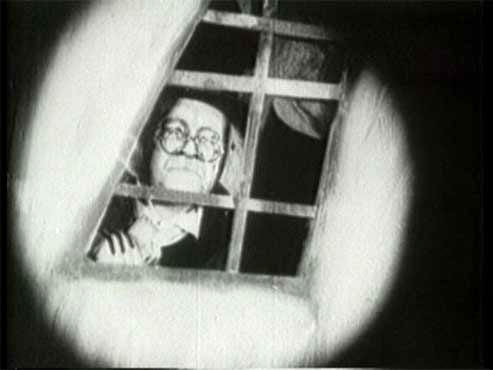
You can’t expect much from a cheap edition when they are going to use the same substandard 16mm reduction print materials from Film Renters Inc. that has been used a dozen times before. The transfer has been made a sound film speed to utilize the muffled orchestral optical soundtrack from the 16mm print. Image details are almost nonexistent and the picture is contrasty. In places, the film is a strain to watch.
Not recommended.
|
This Region 0 NTSC DVD edition has been discontinued
and is . . .
|

|
|
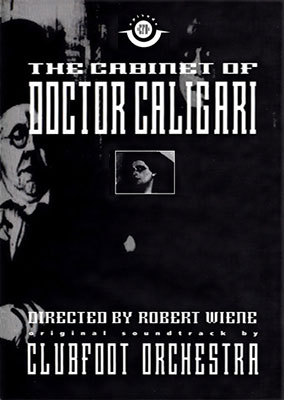 Clubfoot Orchestra Clubfoot Orchestra
2006 DVD edition
The Cabinet of Dr. Caligari (1920), black & white, 50 minutes, not rated.
Clubfoot Orchestra, no catalog number, no UPC number.
One single-sided, single-layered, Region 0 NTSC DVD-R disc; 1.33:1 aspect ratio picture in full-frame 4:3 (720 x 480 pixels) interlaced scan image encoded in SDR MPEG-2 format at ? Mbps average video bit rate (capable of progressive scan upscaling to ? fps); Dolby Digital (AC3) 2.0 stereo sound encoded at ? Kbps audio bit rate; English language intertitles, no subtitles; no chapter stops; standard DVD keepcase; unknown suggested retail price.
Release date: 2006.
Country of origin: USA •
Ratings (1-10): video: 3 / audio: 6 / additional content: 0 / overall: 3.
|
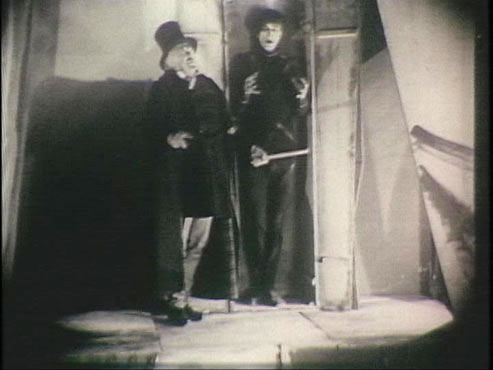
Here is yet another DVD-R edition that uses the same substandard 16mm reduction print materials from Film Renters Inc., but is no better than others we’ve seen. The sound-speed transfer from 1989 is OK but the print itself (no surprises here) is quite speckled, with dust, schmutz and other print defects. This barebones disc does not have a main menu or chapter stops.
The chief attraction of this edition is the accompanying music score by Clubfoot Orchestra, a group of San Francisco musicians led by composer Richard Marriott. The other Clubfoot musicians on this recording are Dave Barrett, Beth Custer, Dick Egner, Josh Ende, Bob Lipton, Doug Morton, Gino Robair and Julian Smedley.
The music is certainly interesting but, otherwise, this edition is not recommended.
|
This Region 0 NTSC DVD-R edition has been discontinued
and is . . .
|

|
|
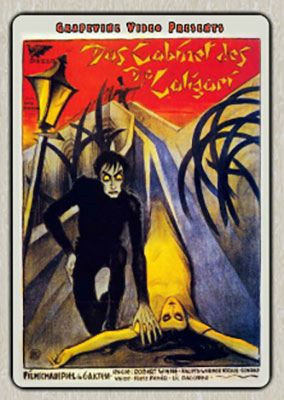 Grapevine Video Grapevine Video
2014 DVD edition
The Cabinet of Dr. Caligari (1920), color-tinted black & white, 67 minutes, not rated.
Grapevine Video, no catalog number, unknown UPC number.
One single-sided, single-layered, Region 0 NTSC DVD-R disc; 1.33:1 aspect ratio picture in full-frame 4:3 (720 x 480 pixels) interlaced scan image encoded in SDR MPEG-2 format at ? Mbps average video bit rate (capable of progressive scan upscaling to ? fps); Dolby Digital (AC3) 2.0 mono sound encoded at ? Kbps audio bit rate; German language intertitles, permanent English language subtitles; chapter stops; standard DVD keepcase; $12.95 (raised to $14.95).
Release date: 17 October 2014.
Country of origin: USA
|
|
This DVD-R edition has likely been mastered from a 16mm reduction print.
The film is accompanied by a music score compiled from preexisting recordings.
|
|
This Region 0 NTSC DVD-R edition is available directly from . . .
|

|
|
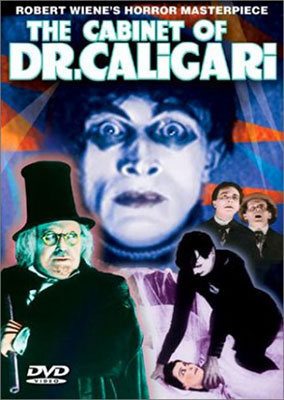 Alpha Video Alpha Video
2002 DVD edition
The Cabinet of Dr. Caligari (1920), black & white, 67 minutes, not rated.
Alpha Home Entertainment, distributed by Oldies.com,
ALP 3170D, UPC 0-89218-31709-4.
One single-sided, single-layered, Region 0 NTSC DVD-R disc; 1.33:1 aspect ratio picture in full-frame 4:3 (720 x 480 pixels) interlaced scan image encoded in SDR MPEG-2 format at ? Mbps average video bit rate (capable of progressive scan upscaling to ? fps); Dolby Digital (AC3) 2.0 mono sound encoded at ? Kbps audio bit rate; English language intertitles, no subtitles; 4 chapter stops; standard DVD keepcase; $6.98 (raised again to $9.99).
Release date: 4 June 2002.
Country of origin: USA
|
|
The majority of Alpha Video’s silent film editions are prepared from 16mm and 8mm reduction prints, and this disc likely doesn’t depart from that trend. It’s probably OK if you can’t force yourself to spend $25.00 on a quality edition.
Despite an advertised running time of 82 minutes, the actual running time of this edition is 67 minutes.
|
This
Region 0 NTSC DVD-R edition is available from
ALPHA VIDEO through . . .
|

|
|
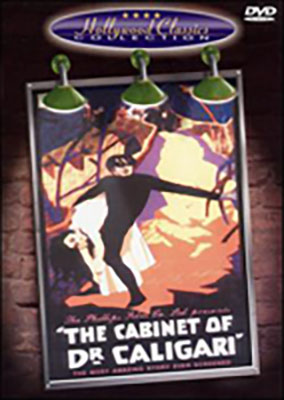 Madacy Entertainment Madacy Entertainment
2003 DVD edition
The Cabinet of Dr. Caligari (1920), black & white, ? minutes, not rated.
Madacy Entertainment, DVD9 9327,
unknown UPC number, unknown ISBN number.
One single-sided, single-layered, Region 0 NTSC DVD disc; 1.33:1 aspect ratio picture in full-frame 4:3 (720 x 480 pixels) interlaced scan image encoded in SDR MPEG-2 format at ? Mbps average video bit rate (capable of progressive scan upscaling to ? fps); Dolby Digital (AC3) 2.0 mono sound encoded at ? Kbps audio bit rate; English language intertitles, no subtitles; chapter stops; standard DVD keepcase; $5.98.
Release date: 4 March 2003.
Country of origin: Canada
|
|
We have not viewed this budget DVD edition, we haven’t even seen an actual copy of it. But you may expect yet another low quality Madacy edition that has likely been prepared from a 16mm reduction print.
What can you expect from a company that markets this film in its “Hollywood Classic Collection”? We do not recommend this edition.
If you own a copy of this disc please consider loaning it to us to review for documentation purposes. We pay postage both ways.
|
This Region 0 NTSC DVD edition has been discontinued
and is . . .
|

|
|
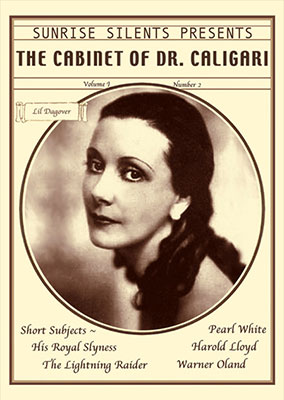 Sunrise Silents Sunrise Silents
2004 DVD edition
The Cabinet of Dr. Caligari (1920), black & white, 65 minutes, not rated, with His Royal Slyness (1919), black & white, 25 minutes, not rated, and exerpts from The Lightning Raider (1919) [unidentified chapter], black & white, 10 minutes, not rated.
Sunrise Silents, V1N2-N, no UPC number.
One single-sided, single-layered, Region 0 NTSC DVD-R disc; 1.33:1 aspect ratio picture in full-frame 4:3 (720 x 480 pixels) interlaced scan image encoded in SDR MPEG-2 format at ? Mbps average video bit rate (capable of progressive scan upscaling to ? fps); Dolby Digital (AC3) 2.0 stereo sound encoded at ? Kbps audio bit rate; English language intertitles, no subtitles; chapter stops; standard DVD keepcase; $14.95.
Release date: 2004.
Country of origin: USA
|
|
We have not viewed this DVD-R edition from public-domain home video company Sunrise Silents.
The film is likely accompanied by a music score performed on MIDI synthesizer.
If you own a copy of this disc please consider loaning it to us to review for documentation purposes. We pay postage both ways.
|
|
SUNRISE SILENTS has discontinued business and this edition is . . .
|

|
|
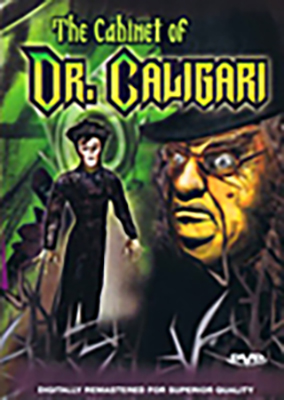 Front Row Entertainment Front Row Entertainment
2003 DVD edition
The Cabinet of Dr. Caligari (1920), black & white, 67 minutes, not rated.
Front Row Entartainment,
unknown catalog number, UPC 0-82554-37512-4.
One single-sided, single-layered, Region 0 NTSC DVD disc; 1.33:1 aspect ratio picture in full-frame 4:3 (720 x 480 pixels) interlaced scan image encoded in SDR MPEG-2 format at ? Mbps average video bit rate (capable of progressive scan upscaling to ? fps); Dolby Digital (AC3) 2.0 mono sound encoded at ? Kbps audio bit rate; English language intertitles, no subtitles; chapter stops; standard DVD keepcase; $5.98.
Release date: 2003.
Country of origin: USA
|
|
It is safe to assume that this low-budget DVD edition has been prepared from low-quality materials — likely a 16mm reduction print.
If you own a copy of this disc please consider loaning it to us to review for documentation purposes. We pay postage both ways. Meanwhile, we do not recommend this edition.
|
This Region 0 NTSC DVD edition has been discontinued
and is . . .
|

|
|
|
Other silent era ROBERT WIENE films available on home video.
Other silent era CONRAD VEIDT films available on home video.
Other GERMAN FILMS of the silent era available on home video.
Other HORROR FILMS of the silent era available on home video.
Other silent film music scores by ROBERT ISRAEL available on home video.
|
|

LINKS IN THIS COLUMN
MAY TAKE YOU TO
EXTERNAL WEBSITES
•
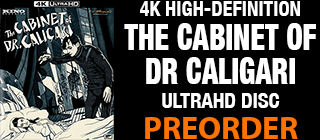
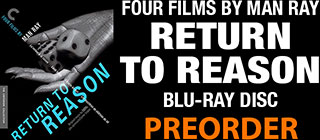
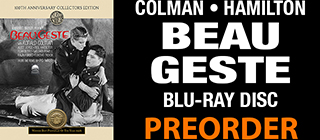

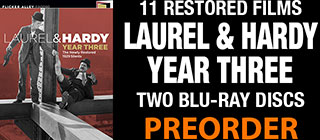
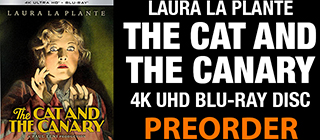


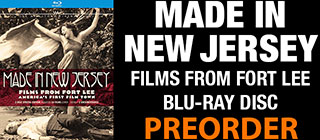
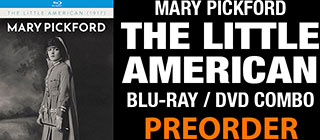
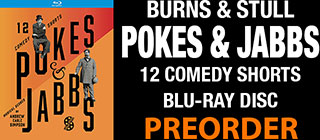
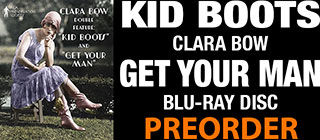
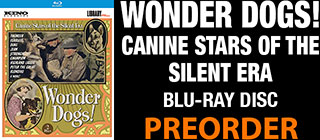
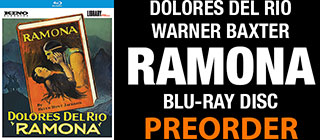
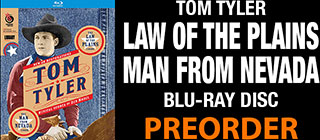
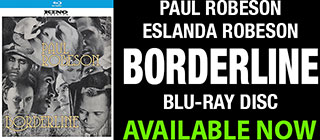
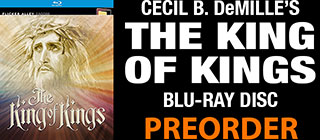
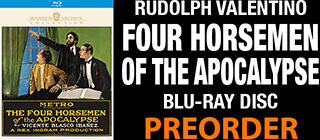
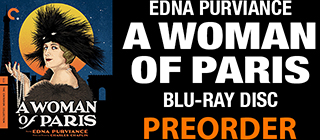
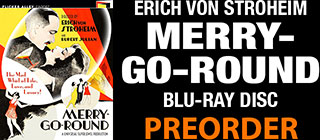

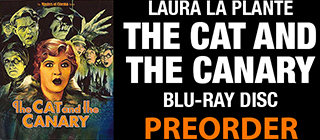
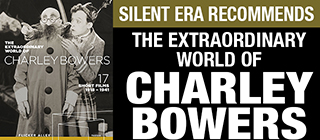
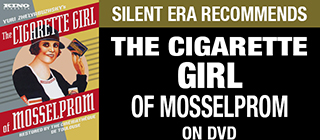
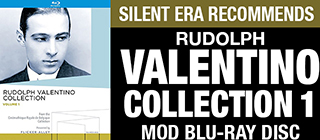
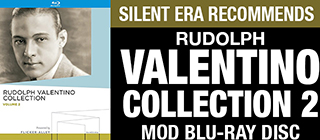

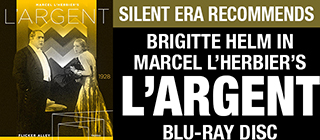
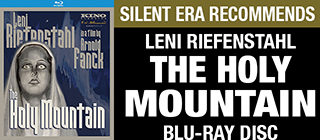

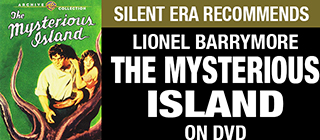
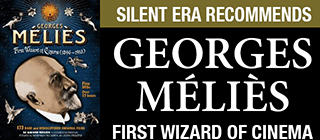
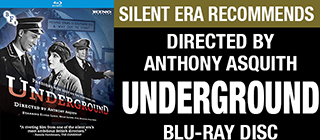
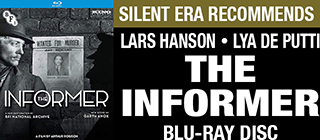
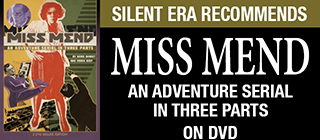
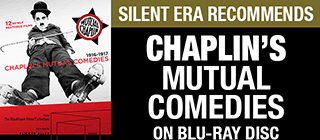

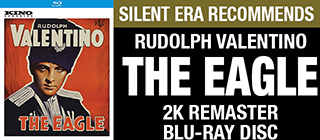
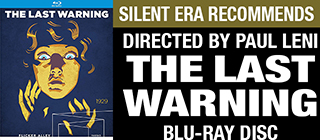
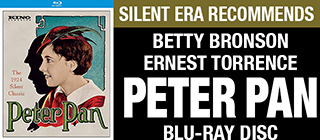
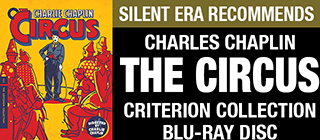
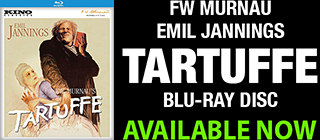
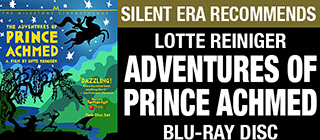
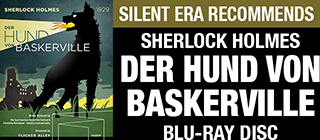
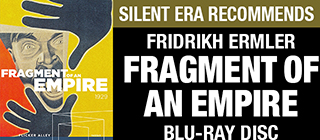
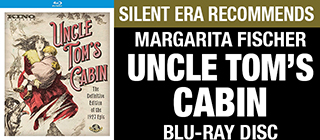
•
|




































